Jonny Bowden's Blog, page 10
November 8, 2016
Turmeric or Curcumin? The Best Natural Remedy for Pain (and So Much More!)
If for some unfathomable reason I lost my mind and decided to join the cast of Survivor, and they allowed me to take just a handful of supplements with me for the season, one of them would definitely be curcumin.
Curcumin has anticancer activity, it supports liver health and it’s a powerful antioxidant. But the one property of curcumin that stands out is its enormous power as an anti-inflammatory.
As you’ll soon see, it may be the most effective natural pain fighter ever seen.
The Heavyweight Champion of Pain Fighters
Curcumin is the general name for a group of active ingredients found in the spice turmeric, the spice that gives curry its yellow color. In India, where 94% of the turmeric in the world originates, curcumin is used to relieve arthritis. It’s good for muscle pains as well as joint inflammation.
You can think of curcumin as a kind of natural NSAID (non-steroidal anti-inflammatory drug, like Advil or Ibuprofen).
A promising treatment for Alzheimer’s?
In animals, curcumin reduces– or even reverses—the formation of amyloid plaques which are found in the brains of Alzheimer’s patients. (And just for the record, the rate of Alzheimer’s in the US is nearly four times that of India—where turmeric is always on the menu!) An exhaustive review of the effect of curcumin (turmeric) on Alzheimer’s disease concluded that “curcumin will lead to a promising treatment for Alzheimer’s disease”.
And then there’s cancer…
A Natural Anti-tumor Agent
There are dozens of published studies indicating that curcumin has an antitumor effect (either reducing the number or size of tumors or the percentage of animals who developed them). One researcher recently called curcumin “an ideal chemopreventive agent with its low toxicity, affordability, and easy accessibility” No wonder. Just for example, a 2013 study showed that curcumin suppresses a cell signaling pathway that drives the growth of head and neck cancer.
While no one is claiming that curcumin cures cancer, there is plenty of reason to believe that it is a really useful adjunct to the diet of everyone concerned with staying healthy.
(For those who want to really delve into the curcumin/turmeric research, my friend Sayer Ji (founder of GreenMedInfo.com) has assembled an exhaustive list—complete with links– to all the studies. You can view those studies here )
Curcumin has powerful antioxidant properties as well, making it a great adjunct to a heart-healthy diet. In one study, curcumin provided significant protection from cataract development.
Another study, in the journal Toxicology, demonstrated curcumin’s significant liver protection abilities. Dr. Mark Stengler, author of the Natural Physician’s Healing Therapies, also recommends it for hepatitis and says that it is frequently used to lower elevated liver enzymes.
As of this writing, the National Library of Medicine (PubMed) lists over 5,000 published studies on the effects of curcumin. My friend Chris Kilham, Fox News’ “Medicine Hunter” is a huge fan, as is Jacob Teitelbaum, MD, author of From Fatigued to Fantastic. And when I spoke at the first annual anti-aging medical conference in Sao Paulo Brazil, the only other English speaking speaker—Dr. Tom O’Bryan—chose curcumin as the subject of his talk, arguing that it was as close to a “super-supplement” as anything we’ve ever seen.
Turmeric or curcumin?
There’s some controversy about this. Some people claim that turmeric (the spice) contains other compounds (like oils) that can be beneficial, but the lion’s share of research has been done on curcumin, which is what most health professionals (including me) recommend. One exception is Dr. Andrew Weil (who recommends turmeric) but when you read his stuff carefully, most of the studies he refers to are on curcumin. Note well that the beneficial compounds in the spice are not well absorbed, but absorption can be significantly enhanced by using black pepper along with turmeric. A compound in pepper—called piperine—significantly increases the bioavailability of curcumin by an astonishing 2000%!
There are many choices for curcumin supplementation, but the downside of many of them is the absorption problem. However I’ve found one company that has created a product that is light years ahead of the rest. And you can get it anywhere- even on Amazon.
Terry Naturally, a top supplement company that specializes in curcumin products, fixed this absorption problem by using a patented special blend of curcumin known as BCM-95 that uses micronized curcumin blended with turmeric essential oils. This produces a formula that’s up to 10 times better absorbed than standard curcumin, and also has an 8-12 hour retention time in the body.
CuraMed by Terry Naturally
This is the formula I take on a daily basis. It’s for all of us who want to get the incredible anti-inflammatory, anti-cancer, and antioxidant benefits of curcumin in a highly absorbable formula that provides great support for a healthy inflammation response, a healthy immune and cardiovascular system, and resistance to free radical (oxidative) damage.
Curamin by Terry Naturally
Curamin Pain Formula by Terry Naturally is what I give all my tennis buddies who are constantly complaining of aches and pains. It’s pretty magical.
The formula combines the BCM-95 curcumin found in Curamin with a purified, highly potent form of boswellia called BosPure™ . Boswellia is one of the most anti-inflammatory herbs on the planet, but it contains a few pro-inflammatory compounds as well. With BosPure™ you get all the anti-inflammatory power of boswellia but the inflammatory compounds have been removed.
Rounding out the formula is nattokinase which has a direct impact on muscle pain via its ability to balance fibrinogen levels in the body.
I gave this formula to my tennis coach Benny, who had pretty much retired from playing due to joint and muscle pain. After two weeks he told me, “Wow! I can move again!” The great naturopathic cardiologist Decker Weiss, NMD says this of Curamin: “When my patients ask for pain relief, my number one recommendation is Curamin. It is safe, effective and I feel confident when I recommend it”.
For supplements mentioned above please visit: https://www.terrynaturallyvitamins.com
November 7, 2016
Vitamin B6
Vitamin B6 was a topic that used to get Robert Atkins, MD—of Atkins Diet fame—piping mad. He felt it was an outstanding example of how divorced the dietary policy makers at the FDA were from what the latest research was saying.
Half tongue-in-cheek, he called Vitamin B6 “the most essential B vitamin”, and thought the government recommendations for daily intake were laughably small. And even so, he felt, the average person was “alarmingly deficient” in this important nutrient.
He may have been right. Vitamin B6 is involved in more than 100 metabolic operations. Along with folic acid and vitamin B12, it’s one of a trio of B vitamins that can bring down blood levels of homocysteine, an inflammatory marker that increases the risk of stroke and heart disease. But B6 may help the heart in other ways, apart from its ability to lower homocysteine. One study found that low B6 levels were an independent risk factor for coronary artery disease.
B6 has a particular role in women’s health. It helps convert estradiol—one of the three forms of estrogen—into estriol, which is the least carcinogenic of the estrogens. Many women who have an overgrowth of the Candida albicans yeast don’t metabolize B6 properly—their bodies can’t convert it into the active form (pyridoxal-5-phosphate). Pregnancy depletes B6, and so do birth control pills.
And because B6 is needed to convert tryptophan into serotonin, it’s very important for mood. Most functional medicine practitioners I know that treat depression with nutritional supplements almost always include B6 in their recommendations.
November 4, 2016
SEVEN PART LIFESTYLE PLAN – STEP SEVEN: Breathe!
You know why they tell you to take a deep breath when you’re piping mad and ready to explode?
It’s because deep breathing is incompatible with anger.
Anger—and frustration, and annoyance, and irritation, and all the other negative toxic emotions—are little factories for the production of stress hormones, specifically cortisol and adrenaline.
And cortisol makes you fat.
It also shrinks a part of your brain called the hippocampus. And it can increase insulin resistance, even if you’re not eating a lot of sugar.
And the conventional wisdom about deep breaths happens to be right. It reduces stress, normalizes blood pressure, reduces blood sugar and inflammation and, if you’re lucky, heal your soul. Or at least soothe it considerably.
Here’s a great way to get started, and you can actually do it in fewer than ten minutes.
1. Lie down in a comfortable position (but try not to fall asleep!). In yoga, this is called Savasana (corpse pose), which should give you some idea of how relaxed you should be. This pose is used in yoga to practice stilling a hyperactive brain by gaining control over breathing.
2. Your arms should be by your sides, rolled out so your palms are facing up.
3. Your legs should be relaxed. Put support (like a rolled towel) under your knees and allow them to naturally roll outward.
4. Close your eyes.
5. Breathe normally for about a minute. Pay attention to your breath.
6. On each exhalation, imagine that all the points of contact beteen your body and the floor are softening.
7. After one or two minutes of normal breathing, graduallybegin to extend the length of your exhalation. Exhaile deeply and slowly.
8. The goal is to inhale fully on a count of four and then exhale fully on a count of eight. In other words, you exhalation should be about twice as long as your inhalation.
9. Continue this 1-2 ratio for four to five minutes.
10.Go back to regular breathing for one to two minutes.
11. You’re done! Eazy peazy.
Listen, don’t get too hung up on the specifics, the counts, or the number of minutes. The idea is as simple as just breathing in slowly, breathing out slowly, and doing it consistently for a bunch of minutes. That’s it.
There are dozens of variations on this theme. Find one that you’re comfortable with and then use it.
A few minutes of deep breathing every day is the cheapest, easiest, and most powerful intervention you can do for your health– and for your well-being in general.
So there you have it. Seven simple steps. Nothing really complicated. Eat real food, most of it earlier in the day, and double up on your water. Go to bed a half hour earlier, think about some cool things in your life once in a while, and take a walk whenever you can. Try to make it a habit. Try to make all of them a habit.
And remember to breathe.
Deeply.
And, whenever you can, with gratitude.
Because wherever you are in your life, I can guarantee you one thing: breathing significantly beats the alternative.
October 31, 2016
SEVEN PART LIFESTYLE PLAN – STEP SIX: Take a walk!
The debate on whether walking is an effective fat burning exercise has been going on for decades, and shows no sign of abating.
But that debate is irrelevant for our purposes. I don’t recommend walking for weight loss, I recommend it for mental health.
Physiologically speaking, walking does a lot of really good things for you. Brisk walking lowers your risk of high blood pressure and diabetes, and—possibly—coronary heart disease. Walking improves glycemic control and triglyceride levels. And research shows that walking can even lower mortality risk. (Those who walked the fastest died the least!)
But all of this isn’t even the reason I recommend going for a 15 minute walk as often as possible.
The real reason to do it can be summed up in two words: Stress reduction.
We know that stress is a major promoter of disease. It can bring on attacks of some conditions (herpes, for example, or even an actual heart attack), it makes other conditions worse, and it makes recovery from illness slower. Managing stress should be one of the highest priorities of anyone wanting to live a longer, healthier life. And walking helps to do that.
There’s quite a lot of published research on something called “ecotherapy”, which is the notion that being exposed to greenery has profound psychological benefits. Mix exposure to greenery with a walk and you’ve got a double whammy of benefits. A much cited study from 1984 in the journal Science showed that gazing at a garden can sometimes speed healing from surgery, infections and other ailments.
The kind of walks I’m recommending you take are not really about fitness, (though we’ll be happy to have some fitness benefits as well). They’re about getting in touch with yourself. They’re about having some down time. They’re about slowing down and smelling roses. They’re about finding a moment of serenity and optimism and awe.
Try adding a 15 minute walk to your routine at least three (if not more) days a week. It will do you nothing but good.
October 30, 2016
Pantothenic Acid (Vitamin B5)
You probably wouldn’t hear much about vitamin B5 except for the fact that it’s gotten a reputation as the “stress vitamin”, or, more accurately, the “anti-stress” vitamin. That’s because vitamin B5 is vitally important to your adrenals, which produce important hormones like cortisol and adrenaline, also known as “stress hormones”. Being under stress eats up vitamin B5, which is why many integrative practitioners suggest supplementing with B5 for those under a lot of stress.
Vitamin B5, also known as pantothenic acid, is an essential nutrient. Pantothenic comes from the Greek word pantos, which means everywhere. That’s because this vitamin is found all over the place, in both plant and animal foods. Pantothenic acid deficiency in humans is almost unheard of, but when scientists experimentally create deficiency in order to study it, they find headache, fatigue, insomnia, intestinal disturbances and impaired antibody production.
These symptoms might be because of the Coenzyme A connection. You see, you need Coenzyme A to metabolize protein, carbs, and fat, and vitamin B5 is needed to create Coenzyme A. That means you basically need vitamin B5 to metabolize your food. Best sources of the vitamin are organ meats like liver and kidney, egg yolks, avocados, cashew nuts and peanuts. Two of the richest sources of pantothenic acid are royal jelly and brewer’s yeast.
October 27, 2016
Ghee vs. Butter: Is it Really a Slam Dunk?
If you’re trying to figure out whether to use ghee or butter, and you go online looking for information, you’ll easily find a million posts arguing that ghee is superior. Fair enough—I’m a big fan of ghee.
But I’m also a big fan of butter. And I don’t think you should always use one rather than the other, no matter what the internet says. I love them both, I use them both (for different things), and as long as both are grass-fed, I’m a fan.
So before you throw out all your butter and start using ghee for everything, let’s dig down just a little deeper into what these two foods do—and don’t do. What exactly is the difference between them anyway?
What exactly is ghee, anyway?
If you remember nothing else from high school chemistry, you probably remember that oil and water don’t mix. If you pour some almond oil (or any other oil) in a jar, and then add an equal amount of water, in about a minute it will look like this:
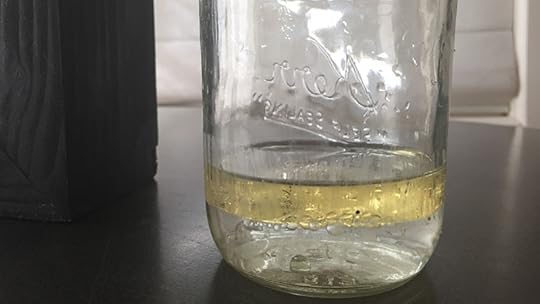
Now, if you shake the mixture up vigorously enough, you can physically force the molecules to stay together. After shaking it for a couple of minutes, the droplets of the oil kind of suspend in the water, making a weird, chalky looking mixture that looks like this:
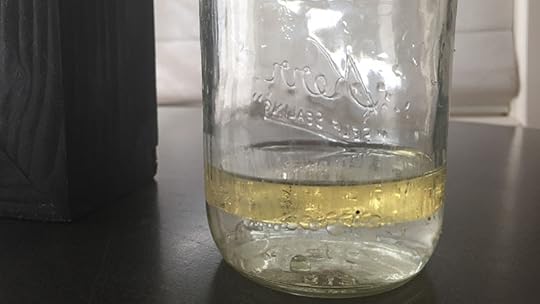
But that’s kind of like forcing rival gang members to socialize by holding a gun to their heads. They don’t like each other, and once you stop forcing them to, they’re going to get as far away from each other as they can. Stop shaking the jar, and after about two minutes, this is what happens.
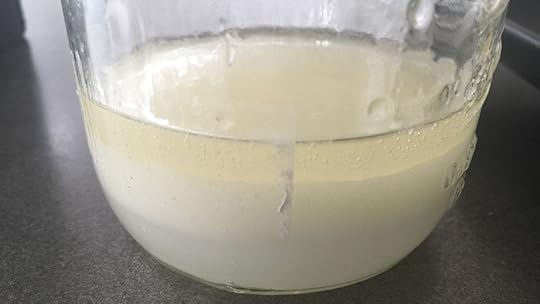
Notice how the oil is already starting to separate and float back to the top?
And a couple minutes later, it looks the same as it did before you shook it.
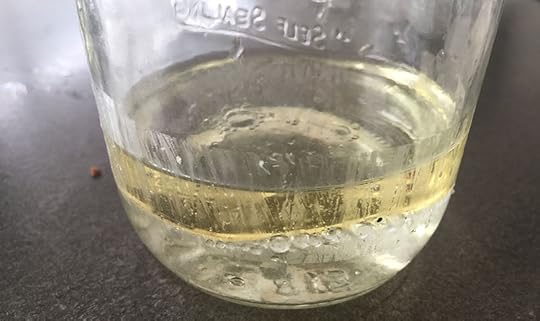
Unless you add an emulsifier to the mix.
An emulsifier accomplishes the same thing as physically shaking the water and oil, only it does it with molecules that form chemical bonds with both water and oil, holding on to both like a chaperone, and making them stay together in a nice creamy mix. In fact, a great example of this looks like this:
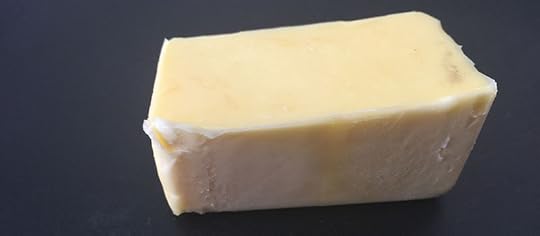
Yup. Butter.
The emulsifiers in butter are the milk solids and milk proteins (like lactose and casein). When you remove the milk solids, and water, you’ve got ghee.
Ghee is really just an uber-clarified butter; all the milk solids and proteins, any sugar, and all the water have been removed leaving, really, only the fat.

Myths and Misconceptions about Ghee vs. Butter
The wonderful reputation of ghee is mostly deserved; but the terrible reputation of butter is not.
Ghee gained its reputation as a health food in India, where it is traditionally used for… well, just about everything. It has a long and respected history as a medicinal and healing food in Ayruvedic (Indian) medicine, a tradition that dates back nearly 5,000 years. Ghee is believed to strengthen the ojas, the vital energy cushion at the root of our well-being and immunity. It doesn’t need to be refrigerated, and is great for cooking. What’s not to like?
Meanwhile, poor old general-purpose butter has been taking a drubbing for the past forty years as a result of the ill-informed and (hopefully dying) low-fat movement, which demonized this wonderfully healthy food ever since Ancel Keys convinced everyone that saturated fat causes heart disease, back in the mid 1980’s. But don’t get me started.
(Anyone who happened not to be around for this embarrassing period in American medicine, the three Time magazine covers below—spanning fifty-three years of dietary madness— kind of tell you what you need to know.)
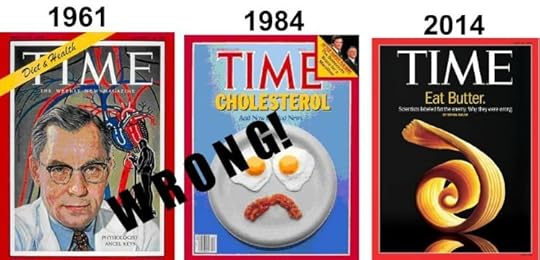
Back to ghee.
There are hundreds of articles listing the health benefits of ghee. If it comes from grass-fed cows, it has CLA— conjugated linolenic acid — a natural fat which has anti-cancer activity. Ghee also has the vitally important vitamin K2. In fact, ghee has a number of fat-soluble vitamins, including vitamin A.
True dat.
You’ll also find a ton of people proclaiming it’s spiritual benefits (I’ve even read that it’s a “spiritual butter”). All this may be so, but it’s a little more subjective and more about ghee’s hallowed status in Ayruvedic medicine.
But here’s the thing. Grass fed butter also has CLA. It also has vitamin K2. And it also has soluble vitamins, like vitamin A.
In fact, very nearly all the nutritional benefits usually listed for ghee are also true for butter.
Yet, there are some significant (and some insignificant) differences.
Heart Health Claims
There are an awful lot of claims that ghee is superior to butter for heart health. But when you dig deeper, every single one of these claims is based on what ghee does to cholesterol levels. And it is true that there is some research that shows that ghee eaters have higher HDL and lower LDL than butter eaters.
Is this significant? I personally don’t think so. Cholesterol is a lousy predictor of heart disease—more than 50% of people admitted to hospitals for cardiovascular disease have perfectly normal cholesterol. But if cholesterol is your concern, ghee is probably a better choice than butter.
However, there are three differences between ghee and butter that I do think are important.
Smoke Point
Because milk proteins smoke at a lower temperature than fat, and because the milk proteins have been removed, ghee has a higher smoke point than butter. This makes it better for cooking at higher temperatures, though the smoke point of ghee will depend on its purity. (Aspery’s Bulletproof Ghee is really pure.)
Dairy Allergies
When you make ghee, you remove all the stuff in dairy that people are sensitive to—like casein, lactose. All that’s left is the fat, and that’s not what causes allergies or sensitivities.
So for people who can’t eat any dairy products, ghee is the perfect choice.
Taste
This last difference is pretty subjective. Personally I don’t like ghee in my high-fat coffee. I prefer a hint of buttery taste. On the other hand, ghee offers a wonderfully neutral flavor that cooks love cause it blends beautifully with foods and never overshadows.
So which is best?
Disappointing thought it may be for the many of us who like clear winners and losers, there’s no clear answer. I think it’s a toss-up.
Ghee is really one of the best fats on the planet. No one is arguing that. You can use it for a million things, it has a higher smoke point than butter, and it’s perfect for people with dairy sensitivities,
But let’s not throw out the butter just yet.
If you have no dairy issues, and you’re cooking at moderate heat, or looking for something to melt on your sweet potato or your rice cauliflower, I see absolutely no reason to avoid high quality grass-fed butter.
On many counts—vitamins, CLA, etc— it’s just as good.
If you would like to try the Bulletproof Ghee– don’t forget to use my special coupon code jonny to receive 10% off.
October 25, 2016
Should You Do A Liver Detox? Yes, and here’s why.
The liver is ground zero for detoxification in the body. It’s also the body’s main fat-burning organ. If it’s not working right, you’re in big trouble.
What kind of trouble? Well, fatty liver disease for one. Known as non-alcoholic fatty liver disease (NAFLD), about 25% of all people in the US are living with it, including 10% of all children. Also known as NASH (non-alcoholic steatohepatitis), those who have it are at a markedly higher risk of developing liver-related death compared with the general population.
Even if you don’t have NAFLD, you’re still in trouble if your liver isn’t performing at its best. The liver processes your hormones, makes triglycerides, is critical for carbohydrate, fat, and protein metabolism, makes cholesterol (and packages it into HDL and LDL), and generally detoxifies you from the panoply of toxins we’re exposed to every day—pesticides, chemicals in the air, PCBs, phthalates, bisphenol-A and pharmaceuticals. Its job is to take those toxins, render them harmless and then get them the heck out of your body.
That’s a huge job, and the liver does it 24 hours a day.
And it needs your help.
Detoxification 101
The liver performs its job of detoxification in two phases. In Phase One, it uses a complex series of enzymes called the Cytochrome P450 enzymes to make toxins more soluble in water so they can be more easily removed from the body (by the kidneys or the liver). Robert Crayhon used to liken this phase to removing the pin from a hand grenade—it’s the first step in disarming the grenade, but it doesn’t do you much good if you can’t throw the damn thing out the window.
Phase two is about throwing the grenade out the window. In phase two the toxins are combined with other substances (a process called conjugation) and then excreted into bile.
Both phases are highly dependent on nutrients.
Given the importance of detoxification to your health, (and to your weight), it’s not surprising that more and more people are turning to detoxes and cleanses.
When you find yourself in a hole, stop digging
The first rule when you find yourself in a hole is to stop digging, and the first rule when you want to detox your liver is to stop adding to its burden. That’s why, during any detox, you only want to eat the cleanest of food—organic, and non-GMO. At least temporarily, you’ll also want to eliminate the “usual suspects” for food intolerances and sensitivities—dairy, wheat, and soy. Obviously, sugar and processed carbs are completely out. And although I’m a huge fan of coffee, it’s probably better to eliminate that as well.
Obviously, processed meats (salami, hot dogs) are out, but grass-fed meat is fine. Vegetables, fruits, all good. Simple, clean and sparse are the key concepts. Eat lightly and cleanly, drink plenty of water, and don’t forget those fresh vegetable juices. You want a nutrient-rich array of foods. Avoid anything you can’t pronounce.
Here’s what I recommend
I recommend a two-week program of clean eating supplemented with a couple of products that will help support what you’re trying to do.
I’ve put together two products that, taken together and used with the clean eating program I’ve outlined above, will have you feeling lighter, more energetic, and less bloated in just about 14 days (or less)!
The first is Integrative Therapeutics’ Whole Body Integrative Cleansing System. It contains a 14-day supply of high quality milk thistle— probably the most helpful herb on the planet when it comes to liver health—together with a gentle, natural laxative and fiber. For 14 days, you take 4 capsules in the morning and 4 in the evening.
The second is a product by Metagenics called UltraClear Renew. Many of you may remember UltraClear, one of the first legitimate medical foods, which has been used in detox programs since I first started in the health field in 1990. UltraClear Renew is specifically intended to support detoxification. You only need to use it for two weeks (after which you can switch to any good protein powder, like Smart Fat grass-fed whey protein).
UltraClear Renew is not a meal replacement powder. It’s specifically formulated to load you up on the nutrients your liver needs most to perform the work of “cleaning up the shop”. You only need to take it for 14 days, and it works beautifully with the Whole Body Integrative Cleansing System. The protein in it is all rice protein, not because that’s “better” than whey (it’s not) but because it’s completely hypo-allergenic; almost no one in the world has a problem with rice, plus it’s completely friendly for vegans and vegetarians.
You can buy the two products together at a special price here- UltraClear renew Vanilla 28.8 oz and Whole Body Cleanse 1 kit.
Eat lightly and super-clean for two weeks, drink plenty of water, take a walk every day, work on getting a good amount of restful sleep, drink at least two glasses of homemade fresh juice a day, drink two Ultraclear Renew shakes and take 8 capsules of the Whole Body Integrative Cleansing System.
You’ll love the results. My favorite weight loss coach Anja Christy did the program exactly this way, and she says she’s never felt better. And though weight loss isn’t the primary goal of a detox program, she also lost some weight. She says it’s one of the best “jump-starts” she’s ever found. And she’s never looked better!
October 24, 2016
Niacin (Vitamin B3)
Vitamin B3 is one of a select group of vitamins—along with C, D, B12 and thiamine– that actually has a deficiency disease associated with it. In the case of niacin, the disease is pellagra, a disease whose symptoms are often called the “Four D’s”: dementia, diarrhea, dermatitis, and death!
We don’t see much pellagra anywhere in the Western world, but it’s pretty clear that you’d be in deep trouble if you didn’t get enough niacin. Luckily, getting enough niacin to prevent pellagra is pretty easy to do.
As with other vitamins, the amount needed to prevent a horrible deficiency is not necessarily the same as the optimal amount. Niacin helps convert the food you eat into energy. Niacin also helps your body make both sex hormones and stress hormones, and it’s also been shown to suppress inflammation. Population studies have shown that people who get more niacin in their diet have less risk of Alzheimer’s(1)
Various forms of niacin have been used as supplements in the treatment of various health conditions, but the supplemental use of niacin is beyond the scope of this book.
October 20, 2016
annmarie Skin Care
Hi everyone,
As a lot of you know, I’m out on the tennis court a couple hours a day, and in Southern California, that requires sunscreen. So recently I began to look into the sunscreens I’ve been using, and realized that most of them are loaded with really toxic chemicals.
Which got me thinking about the stuff we put on our faces and our bodies.
I mean, think about it. The skin absorbs the stuff we put on it—otherwise why would there be testosterone patches?
And if we’re putting chemicals on our face—whether with sunscreen or with skin care products—guess where those chemicals are going to wind up?
Exactly. In our bodies, in our bloodstream, and ultimately in our liver, where they will tax its already over-worked detoxification pathways.
Not a good scenario. And ridiculous, actually, when you think about it. We put so much effort into eating clean food, and then we turn around and slather our faces with toxic creams and moisturizers that can disrupt our endocrine system, screw with our hormones and even damage our DNA.
As my colleague Chris Kresser says, “When it comes to chemicals and toxins… what you put on your skin may be even more important than what you eat!”
Enter Annmarie Gianni Skin Care.
I first met Kevin and Annmarie Gianni when Kevin interviewed me for his podcast about a decade ago. Kevin and Annmarie were kind of like modern day hippies. They were on a quest for great health and spiritual fulfillment, and they wanted to make a difference in the world—you know, all that good stuff. Ultimately, they closed down their t personal training business, sold their house, took off in a big van, and traveled around the country like modern-day medicine hunters, looking to uncover the best health secrets, the best organic food, the best ingredients, and the best places to live.
Annmarie and Kevin noticed that the majority of skin care products were pretty much the chemical equivalent of the standard American junk food diet. Bad, toxic ingredients, chemicals, compounds tested on animals, dubious ingredients… all the usual suspects.
They set out to create a truly unique line of handcrafted products with nontoxic ingredients… and they did.
Now look. I realize I’m a guy, but I’m also pretty metrosexual and I love my products. (Michelle teases me that I take more products on vacation than she has in her entire bathroom—not exactly true, but close.) I’ve used just about every product line you can imagine, including the wildly expensive Perricone line. And I can tell you that I have never used stuff that feels as good going on, smells as good, and that I look forward to using. It makes my skin look—and feel—amazing. No kidding.
Apparently I’m not alone in loving this stuff. Annmarie Skin Care has been enthusiastically endorsed by almost every one of my colleagues in the health space, from Mark Hyman to JJ Virgin. We all use it, we all love it, and when you try it, you’ll see why. This stuff really works.
And the good news is that Annmarie and her team have put together a trial package where you can try any of 3 special sample kits that include some of their bestselling products. You can choose a sample kit based on your skin type—normal, oily, or dry.
These kits are $10 each AND when you order one you’ll receive a $10.00 off coupon that you can use for a future purchase. Annmarie Skin Care is also offering FREE SHIPPING for these kits—anywhere in the world.
Also, when you get a sample kit today, you’ll get Annmarie’s Skin Detox Guide. This beautifully laid out, in-depth guide will show you how to get clear, bright skin and feel gorgeous from the inside out. You’ll learn how to improve the health and beauty of your mind, body, and skin through food, facial exercises, tapping, affirmations, movement, and more!
This comprehensive, easy-to-read Skin Detox Guide includes a 21-Day Plan with delicious recipes, exercises to boost your mood, affirmations to increase your confidence, and a complete skin care regimen with tips from Annmarie Skin Care’s in-house esthetician so you look and feel your best!
If you order a sample kit today, you’ll get the skin detox guide—free—a $24.95 value.
Get Your Sample Kit and Bonuses Here
Warmly,
Dr. Jonny
P.S. Two of the products I’m absolutely crazy about right are the aloe herb cleanser, and the Dead Sea Facial Scrub. You can try both of these as part of the sample kit offer I mentioned above. Check it out!
October 18, 2016
SEVEN PART LIFESTYLE PLAN-STEP FIVE: Celebrate the Awesome
Our thoughts and feelings have a profound effect on our physiology.
You may have heard said, “what you think about expands?” All that really means is that what you pay attention to, what you spend psychic energy on, has resonates deeply in your body and has a significant effect on your whole well-being. In fact, the entire science of psychoneuroimmunology is the study of how what our thoughts affect our immune system.
And while we can’t just “wish” toxic feelings away—anger and resentment have an annoying way of hanging around even when we don’t want them there— what we can do is replace them.
And it’s easy to do.
Just make a list, right now, of three things in your life that are absolutely awesome.
Then read it. Carry it with you as a reminder… you’ll know when to use it!
I’m willing to bet if you’re reading this article that you’ve got three things you can point to that are terrific in your life. Even if you’re struggling financially, or in a difficult relationship, or you hate your weight, I’ll still bet dollars to Krispy Kremes that you can find at least three things that are just amazing about your life. (Hint: If you’re reading this, your eyes work. That alone is pretty awesome, even though we usually take our vision for granted.)
Take a look at the moon and stars on a clear night. Or take a walk somewhere quiet and green. Or play with a puppy and get some puppy kisses. Or look deeply into the eyes of another person, preferably someone you love.
There’s awesome all around us– you don’t really have to look very far, you just have to open your eyes (and your heart).
There’s even research to support the beneficial physiological effects of positive emotions, especially awe. Researchers found that the feeling of awe— measured in two different ways—was the strongest predictor of lower levels of proinflammatory cytokines! That means that our thoughts can actually lower inflammation, a major contributor to every single degenerative disease on the planet!
I once did an experiment I called “The gratitude challenge”. I woke up every morning for 30 days and wrote down ten things that I was grateful for. Even if I was in a shitty mood, just focusing on the awesome things in my life brightened my day and got me up on the “right” side of the bed. It’s like working out in the morning—it just sets a positive tone for the rest of the day.
I gave that challenge to the members of my membership site and the feedback was… well, awesome.
When people say “Cultivate an attitude of gratitude”, I’m pretty sure this is what they’re talking about. It’s pretty hard to be angry—or frustrated—or stressed—when you’re focused on terrific things.



